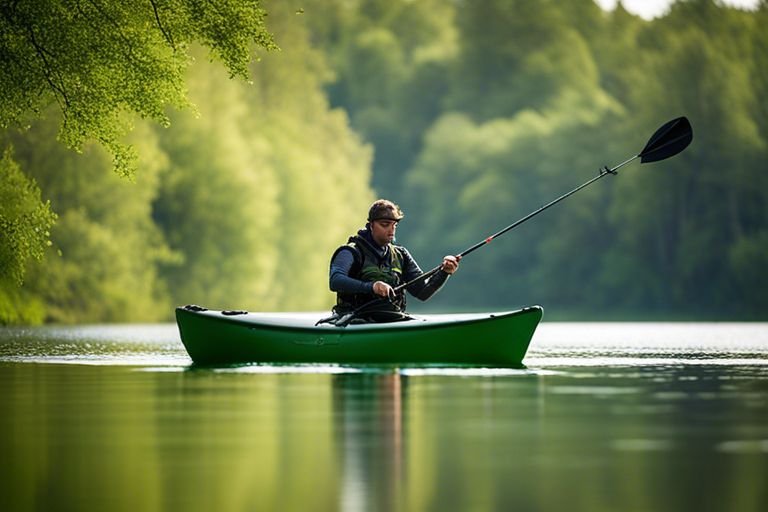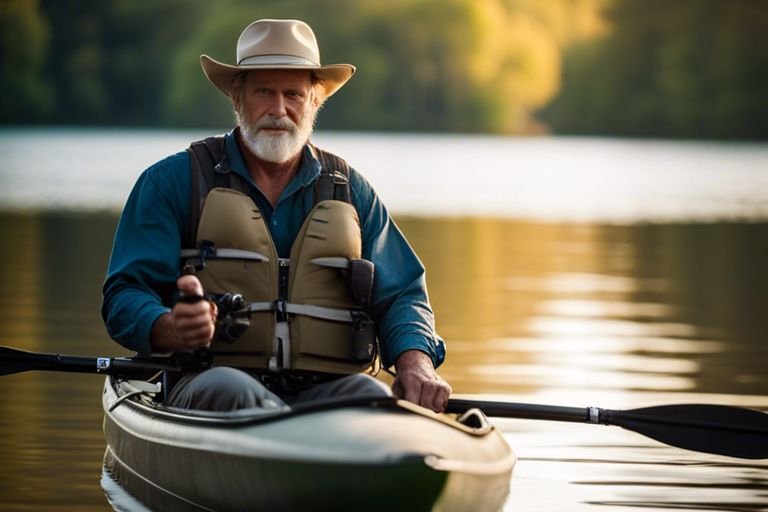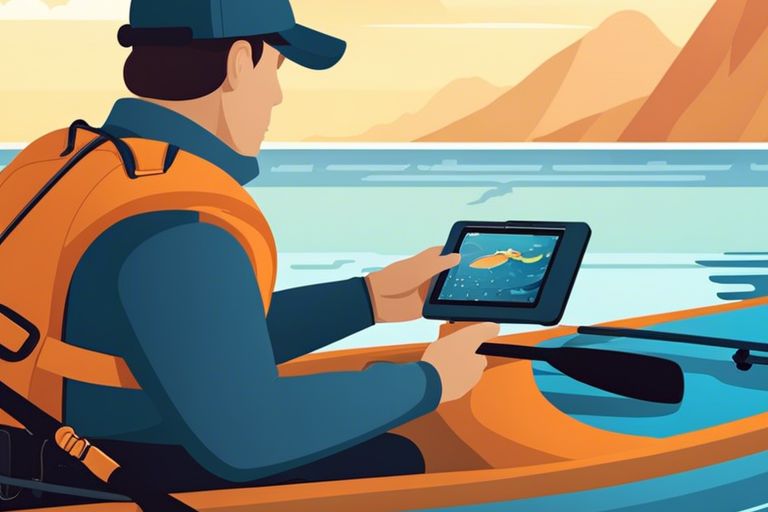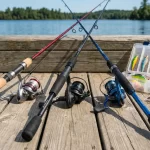As I sit in my kayak, surrounded by the serene beauty of nature, I’m reminded of why I fell in love with fishing in the first place. It’s not just about reeling in the big catch, but about respecting the delicate balance of our aquatic ecosystems.
Over the years, I’ve learned that every decision I make, from the gear I use to the way I handle fish, has a ripple effect on the environment.
That’s why I’m passionate about green kayak fishing, a way to enjoy this incredible sport while minimizing our impact and preserving it for generations to come.
By making conscious choices, we can cast our lines with a clear conscience, knowing we’re doing our part to protect the waters we love.
Key Takeaways:
- Eco-Friendly Gear Choices Matter: Switching to biodegradable lines, lead-free sinkers, and jigs, as well as kayaks made from recycled plastics, can significantly reduce plastic accumulation and harm to aquatic life.
- Responsible Fishing Practices Are Key: Adopting catch-and-release methods, using barbless hooks, handling fish gently, and following fishing regulations (like size and bag limits) help maintain healthy fish populations and preserve the ecosystem.
- Leave No Trace: Packing out all trash, using reusable water bottles, and respecting wildlife habitats (including nesting areas) are crucial to minimizing our impact on the environment and preserving the natural beauty of our waterways.
- Education and Community Are Essential: Sharing knowledge and encouraging others to adopt green kayak fishing practices can create a collective positive impact on the environment and ensure a sustainable future for our sport.
- Every Decision Counts: Recognizing that every choice we make, from gear to fishing practices, has a ripple effect on the ecosystem, and making conscious decisions to minimize our impact, is crucial to preserving our aquatic environments for generations to come.
Essential Eco-Friendly Gear
For any angler looking to make a positive impact on the environment, choosing the right gear is crucial. It’s not just about catching fish; it’s about doing so in a way that minimizes harm to the ecosystem.
Sustainable Fishing Gear Options
To start, let’s talk about the gear itself. Traditional monofilament lines, for instance, can take hundreds of years to decompose and often end up as plastic waste in our waterways.
By switching to biodegradable lines, we can significantly reduce the amount of plastic pollution in our oceans.
Benefits of Eco-Friendly Gear
The benefits of eco-friendly gear are twofold. Not only do they reduce our environmental footprint, but they also promote a more responsible and sustainable approach to fishing.
Plus, using eco-friendly gear sends a powerful message about our values as anglers. By choosing gear that’s better for the environment, we’re showing that we care about the long-term health of our ecosystems and the creatures that inhabit them.
This is especially important when it comes to protecting vulnerable species and preserving the delicate balance of our aquatic ecosystems.
By making conscious choices about our gear, we can ensure that our passion for fishing doesn’t come at the expense of the planet.
Responsible Fishing Practices
Some of the most critical aspects of green kayak fishing involve the way we interact with the fish themselves.
By adopting responsible fishing practices, we can ensure the long-term health of fish populations and the ecosystems they inhabit.
Catch and Release Techniques
Practices like catch and release are vital in maintaining the balance of our aquatic ecosystems.
When done correctly, catch and release can be a powerful conservation tool, allowing fish to thrive and reproduce while minimizing the impact of our sport.
Following Fishing Regulations
Fishing regulations are in place for a reason – to protect fish populations and ensure their sustainability.
By adhering to size and bag limits, respecting seasonal closures, and staying informed about local regulations, we can help prevent overfishing and protect vulnerable species.
Fishing regulations might seem restrictive, but they’re a lifesaver for many fish populations. For example, did you know that some species, like sturgeon, can take up to 20 years to reach reproductive maturity?
By respecting catch limits and closed seasons, we give these incredible creatures the chance to thrive.
So, take the time to familiarize yourself with local regulations and do your part in preserving the health of our aquatic ecosystems.
Keep in mind, that responsible fishing practices are just one aspect of green kayak fishing.
By combining these practices with eco-friendly gear choices and a “Leave No Trace” philosophy, we can create a more sustainable future for our sport and the environment we love.
Minimizing Your Footprint & Leaving No Trace
All of us who venture into nature have a responsibility to minimize our impact on the environment.
As green kayak fishermen, we must be mindful of our actions and strive to leave the waterways and surrounding ecosystems in the same condition as when we arrived.
Responsible Waste Disposal
Tracking back to the basics, responsible waste disposal is crucial in maintaining a pristine environment.
I always make it a point to pack out all trash, including those pesky bits of fishing line, and encourage you to do the same.
It’s astonishing how a small piece of carelessness can have a significant impact on the ecosystem.
Respecting Wildlife and Their Habitat
Responsibly sharing the waters with wildlife is necessary for green kayak fishing. I’ve learned to observe animals from a respectful distance, using binoculars instead of encroaching on their space.
It’s vital to be mindful of nesting areas, especially during breeding seasons, and give these creatures the space they need to thrive.
It’s crucial to recognize that our presence can have a profound impact on the delicate balance of aquatic ecosystems.
For instance, did you know that even a single discarded fishing line can entangle and kill multiple birds and fish?
By being aware of our surroundings and taking steps to minimize our footprint, we can ensure that these incredible creatures continue to flourish.
Recall, that a healthy planet means a brighter future for both fish and anglers alike.
Eco-Friendly Kayak Maintenance
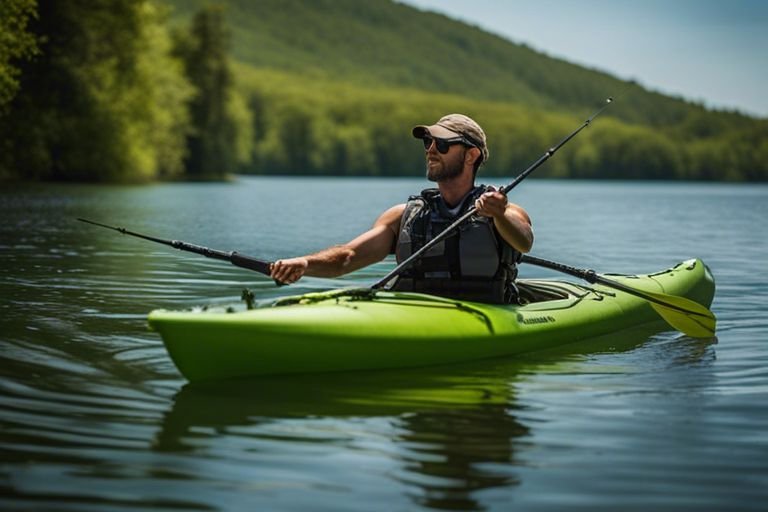
Despite the excitement of hitting the water, it’s important to remember that our kayaks require regular TLC to ensure they remain in top condition and don’t harm the environment.
A well-maintained kayak not only prolongs its lifespan but also reduces the likelihood of accidents and minimizes waste.
Cleaning and Storing Your Kayak
Around the same time I upgraded from my trusty bamboo pole, I learned the importance of cleaning and storing my kayak properly.
A simple rinse with soap and water after each use prevents dirt and grime from building up while storing it in a dry, shaded area shields it from harsh UV rays and extreme temperatures.
Regular Maintenance for a Longer Lifespan
Kayak maintenance is an art that requires attention to detail and a willingness to get your hands dirty.
By performing routine checks on your kayak’s hull, cockpit, and accessories, you can identify potential issues before they become major problems.
For instance, inspecting your kayak’s hull for scratches and cracks allows you to address them promptly, preventing water from seeping in and causing damage.
Regularly lubricating moving parts, such as footrests and hatches, ensures smooth operation and prevents corrosion.
Additionally, checking your kayak’s weight capacity and ensuring it’s properly loaded prevents overloading, which can lead to structural damage or even accidents.
By staying on top of maintenance, you’ll enjoy a safer, more enjoyable fishing experience while also reducing waste and minimizing your environmental impact.
Choosing the Right Fishing Location
To ensure a successful and eco-friendly fishing trip, it’s imperative to choose the right location.
This decision can make all the difference in minimizing our impact on the environment and preserving the delicate balance of our aquatic ecosystems.
Identifying Eco-Friendly Fishing Spots
Eco-conscious anglers like myself always look for spots with minimal human impact. When scouting for a new location, I seek out areas with healthy vegetation, minimal litter, and thriving aquatic life.
These indicators suggest that the ecosystem is resilient and can support a sustainable fishing practice.
Avoiding Sensitive Ecosystems
Fishing in sensitive ecosystems can have devastating consequences. As responsible anglers, we must avoid areas with fragile habitats, such as coral reefs, seagrass beds, or spawning grounds.
Spots like these are often protected by conservation efforts, and for good reason. Damaging these ecosystems can lead to the decline of entire species, not to mention the long-term consequences for the entire food chain.
By avoiding these areas, we can help preserve the biodiversity of our waterways and ensure a healthier ecosystem for future generations.
Recall, that choosing the right fishing location is a critical step in green kayak fishing.
By being mindful of our surroundings and avoiding sensitive ecosystems, we can enjoy this incredible sport while preserving the beauty and wonder of our aquatic world.
Sustainable Fishing Techniques
Your approach to fishing can have a significant impact on the environment.
As I’ve learned from my own experiences, adopting sustainable fishing techniques is crucial to preserving the delicate balance of our aquatic ecosystems.
From trolling and casting methods to avoiding bycatch and protecting non-target species, every decision counts.
Trolling and Casting Methods
Trolling slowly and deliberately helps reduce fuel consumption and minimizes the disturbance of marine habitats.
When casting, aim for accuracy to avoid snagging or losing tackle, which can harm fish and other aquatic life.
Check out this Fisher’s Guide to Kayak Fishing for more tips on refining your technique.
Avoiding Bycatch and Protecting Non-Target Species
Methods like using circle hooks and avoiding fishing in areas with known bycatch species can significantly reduce the impact of our fishing activities.
Additionally, being mindful of the types of bait and lures used can help minimize the attraction of non-target species.
Understanding the importance of avoiding bycatch and protecting non-target species is critical.
Did you know that bycatch can account for up to 40% of global catch?
It’s a staggering statistic that highlights the need for responsible fishing practices.
By taking steps to minimize bycatch, we can help preserve the diversity of marine life and ensure the long-term health of our ecosystems.
Keep in mind, that every small action counts, and collective efforts can lead to significant positive change.
The Importance of Conservation Efforts
Once again, as green kayak fishermen, we must recognize that our actions have a ripple effect on the environment.
It’s not just about catching fish; it’s about preserving the delicate balance of our aquatic ecosystems.
As I always say, “We’re not just fishing for fish, we’re fishing for the future.”
Conservation efforts are crucial to maintaining healthy fish populations, protecting habitats, and preserving the beauty of our waterways.
By supporting organizations dedicated to conservation, participating in citizen science projects, and adopting eco-friendly practices, we can make a significant impact.
For more information on gear and tactics for going green, check out Gear and Tactics for Going Green (Or Greener) With Your Fishing.
Supporting Local Conservation Organizations
Supporting local organizations that work tirelessly to protect our waterways is imperative.
These groups often rely on donations and volunteers to carry out their mission.
By contributing to their efforts, we’re investing in the future of our sport and the health of our planet.
Participating in Citizen Science Projects
To truly make a difference, we must get involved in the conservation process. Participating in citizen science projects allows us to contribute valuable data and insights that inform conservation efforts.
The data collected through these projects can help identify areas of concern, track changes in fish populations, and inform policy decisions.
For example, citizen scientists can help monitor water quality, track invasive species, and report on habitat destruction.
By getting involved, we can make a tangible impact on the health of our waterways.
The reality is, that conservation efforts require a collective effort. By working together, we can ensure that our passion for kayak fishing doesn’t harm the environment.
Instead, we can use our love for the sport to drive positive change and protect the waters we cherish.
Green Kayak Fishing Communities
After years of solo paddling, I realized that the most significant impact comes not from individual efforts, but from collective action.
Joining forces with like-minded anglers can amplify our eco-friendly practices and create a ripple effect that resonates throughout the fishing community.
Joining Online Forums and Social Media Groups
Fishing for connections online can lead to a treasure trove of knowledge and support.
Online forums and social media groups dedicated to green kayak fishing provide a platform to share tips, ask questions, and learn from others who share your passion for sustainable angling.
I’ve discovered innovative solutions to common problems, from DIY tackle modifications to eco-friendly kayak cleaning methods, all thanks to the collective wisdom of these online communities.
Participating in Local Fishing Clubs and Events
Any chance to gather with fellow anglers is an opportunity to spread the green kayak fishing gospel.
Local fishing clubs and events offer a platform to share your knowledge, learn from others, and build a sense of community around sustainable angling practices.
Green kayak fishing enthusiasts often organize clean-up initiatives, habitat restoration projects, and educational workshops, providing a chance to get involved and make a tangible impact.
I’ve participated in local events where we’ve removed trash from waterways, planted aquatic vegetation, and even helped with fish population surveys.
These collective efforts not only improve the environment but also foster a sense of camaraderie among like-minded anglers.
By working together, we can create a groundswell of support for eco-friendly practices that benefit both the environment and the fishing community as a whole.
Eco-Friendly Fishing Apparel and Accessories
Not only does our gear have an impact on the environment, but so do the clothes we wear and the accessories we use while fishing.
As anglers, we spend a significant amount of time outdoors, and our apparel choices can either contribute to or mitigate the environmental issues we’re trying to address.
Concerning fishing apparel, I’ve learned to prioritize sustainability over style (although, let’s be real, eco-friendly gear can be pretty cool too!).
Sustainable Materials and Manufacturing Practices
Apparel made from sustainable materials like recycled polyester, organic cotton, and Tencel not only reduces waste but also conserves resources.
Look for brands that adopt environmentally responsible manufacturing practices, such as using renewable energy sources, minimizing water usage, and implementing recycling programs.
Choosing Environmentally Friendly Brands
Apparel companies that prioritize sustainability are becoming more mainstream, and it’s crucial to support them. By choosing eco-friendly brands, we promote responsible practices and encourage others to follow suit.
Environmentally conscious brands often go beyond just using sustainable materials; they also focus on reducing waste, implementing recycling programs, and promoting fair labor practices.
For instance, some companies use a “take-back” program, where they collect old gear and recycle it into new products, reducing the amount of waste that ends up in landfills.
When shopping for fishing apparel, look for brands that have made a commitment to sustainability and transparency in their supply chain.
Every dollar we spend is a vote for the kind of world we want to live in, so let’s vote for a more sustainable future.
Reducing Carbon Footprint While Fishing
Now, as green kayak fishermen, we need to acknowledge that our passion for the sport comes with a price – a carbon footprint that contributes to climate change.
It’s imperative to recognize the impact of our actions and take steps to minimize our carbon footprint while fishing.
Carpooling and Using Public Transportation
With a little planning, we can reduce the number of vehicles on the road, which means fewer emissions and less pollution.
Carpool with friends or join a fishing club to share transportation costs and lower your carbon footprint.
Offsetting Carbon Emissions from Fishing Trips
Transportation to and from fishing spots significantly contributes to our carbon footprint. By offsetting these emissions, we can compensate for the environmental impact of our travels.
Public awareness about carbon offsetting has grown significantly in recent years, and it’s now easier than ever to calculate and offset our emissions.
For example, a round-trip drive from New York to Florida can generate around 220 kg of CO2 emissions.
By investing in renewable energy projects or reforestation programs, we can balance out our carbon footprint and support sustainable development.
It’s a small price to pay for the peace of mind that comes with knowing we’re doing our part to reduce our impact on the environment.
Green Kayak Fishing for Beginners
Keep in mind that transitioning to eco-friendly kayak fishing practices takes time, patience, and practice.
As someone hooked on fishing for over 25 years, I’ve learned that it’s a journey, not a destination.
In this chapter, I’ll guide you through the vital steps to get started with green kayak fishing.
Getting Started with Eco-Friendly Fishing Gear
To make a positive impact on the environment, start by reassessing your fishing gear. Ditch traditional monofilament lines and opt for biodegradable alternatives that won’t contribute to plastic accumulation in our waterways.
Similarly, choose lead-free sinkers and jigs to protect both fish and birds from toxic materials.
When identifying a kayak, consider those made from recycled plastics, which offer the same performance while reducing our reliance on virgin materials.
Essential Skills for Responsible Fishing Practices
Fishing responsibly is crucial to preserving the delicate balance of our aquatic ecosystems. Catch and release is a fundamental aspect of green kayak fishing, ensuring the longevity of fish populations.
Always use barbless hooks to minimize injury during release, and handle fish with wet hands to protect their sensitive slime coating.
Gear up with the right knowledge, and you’ll be well on your way to becoming a responsible angler.
Understanding proper revival techniques, such as gently moving the fish back and forth to encourage water flow over its gills, increases its chances of survival.
Moreover, respecting fishing regulations, including size and bag limits, protects species during vulnerable periods.
By mastering these vital skills, you’ll be contributing to the long-term health of our planet’s incredible aquatic ecosystems.
Advanced Green Kayak Fishing Techniques
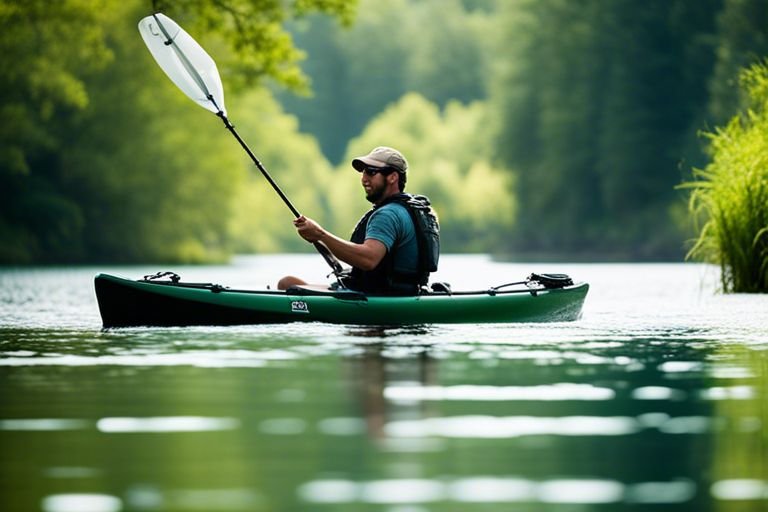
Many of us have mastered the basics of green kayak fishing, but it’s time to take our skills to the next level.
By incorporating advanced techniques into our fishing routine, we can increase our catch rates while minimizing our impact on the environment.
Here are some advanced techniques to try:
| Technique | Benefits |
|---|---|
| Downriggers and planer boards | Increased catch rates, reduced bycatch, and improved fish handling |
| Fly fishing and saltwater fishing | Targeted species, reduced gear loss, and enhanced angling experience |
| Trolling and chumming | Improved catch rates, reduced fuel consumption, and enhanced fish behavior observation |
| Fish finding and sonar technology | Increased catch rates, reduced fishing time, and improved understanding of fish behavior |
Using Downriggers and Planer Boards
Techniques like downriggers and planer boards allow us to target specific depths and species, reducing bycatch and improving fish handling.
By using these tools, we can also reduce gear loss and minimize our impact on the seafloor.
Mastering Fly Fishing and Saltwater Fishing
One of the most rewarding aspects of green kayak fishing is mastering fly fishing and saltwater fishing.
These techniques require patience, skill, and a deep understanding of fish behavior, but the rewards are well worth it.
A key aspect of fly fishing and saltwater fishing is understanding the specific habitats and behaviors of your target species.
By studying the intricacies of these ecosystems, we can develop a deeper appreciation for the fish we’re trying to catch and the environments they inhabit.
This knowledge also allows us to make more informed decisions about our gear choices, fishing locations, and handling techniques, ultimately reducing our impact on the environment.
Bear in mind, that advanced techniques require advanced responsibility. Always follow local regulations, handle fish with care, and respect the environment.
Overcoming Challenges in Green Kayak Fishing
As I’ve examined deeper into the world of green kayak fishing, I’ve encountered my fair share of obstacles.
From inclement weather to fishing regulations, there are plenty of hurdles to navigate.
But with a little creativity and determination, you can overcome these challenges and continue to enjoy your eco-friendly angling adventures.
Dealing with Inclement Weather Conditions
Kayak fishing in harsh weather can be a real challenge. Strong winds, heavy rain, and scorching sun can make it difficult to stay comfortable and focused on the water.
To combat this, I always check the forecast before heading out and plan accordingly. Bringing the right gear, such as a waterproof jacket or a sunshade, can make all the difference.
And if the weather takes a turn for the worse, don’t be afraid to call it a day and head back to shore – safety should always be your top priority.
Coping with Fishing Regulations and Restrictions
With the ever-changing landscape of fishing regulations, it can be tough to stay on top of what’s allowed and what’s not.
To avoid any potential issues, I make sure to research the local regulations before each trip, taking note of any closed areas, size limits, and bag restrictions.
It’s imperative to respect these rules, not just to avoid fines, but to ensure the long-term health of our aquatic ecosystems.
Restrictions may seem like a hassle, but they’re in place to protect the very fish we’re trying to catch.
By adhering to these regulations, we’re helping to maintain healthy fish populations and preserve the delicate balance of our ecosystems.
And let’s be honest, there’s nothing more frustrating than seeing a beautiful fish caught only to realize it’s undersized or out of season – a wasted catch is a wasted opportunity.
So, take the time to familiarize yourself with local regulations and do your part in preserving our fisheries for generations to come.
To wrap up
From above the water’s surface to the depths of our conscience, embracing green kayak fishing is a journey that requires attention to every detail.
As I reflect on my path, I realize that it’s not just about the fish we catch, but about the ripple effects of our actions on the environment.
By choosing eco-friendly gear, practicing responsible fishing, and adopting a “Leave No Trace” mindset, we can ensure that our passion for kayak fishing becomes a force for good.
So, let’s cast our lines with a clear conscience, knowing that every decision we make today will shape the waters of tomorrow.

